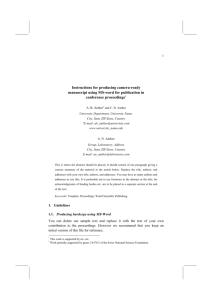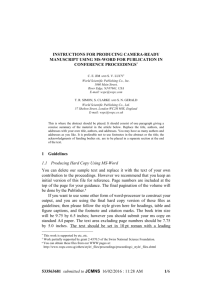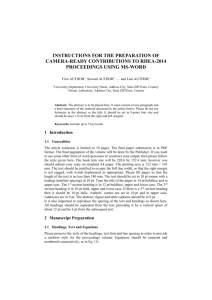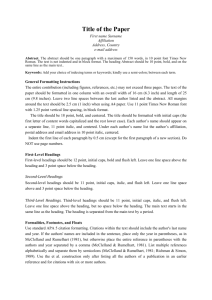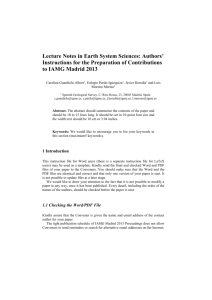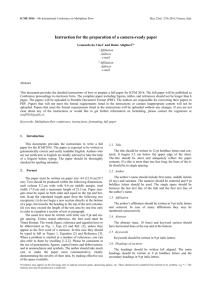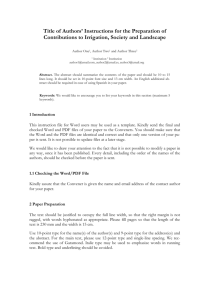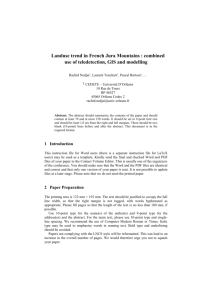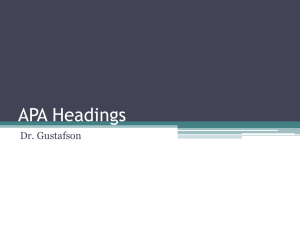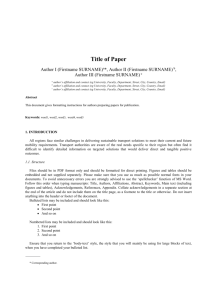Word file paper template with instructions
advertisement
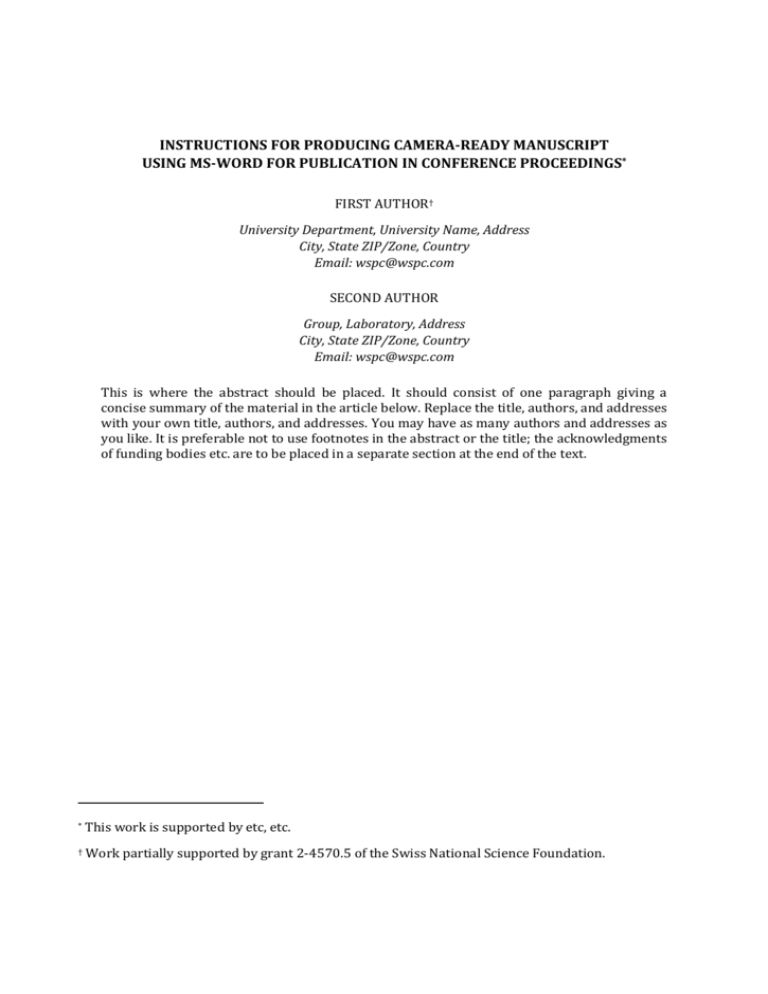
INSTRUCTIONS FOR PRODUCING CAMERA-READY MANUSCRIPT USING MS-WORD FOR PUBLICATION IN CONFERENCE PROCEEDINGS* FIRST AUTHOR† University Department, University Name, Address City, State ZIP/Zone, Country Email: wspc@wspc.com SECOND AUTHOR Group, Laboratory, Address City, State ZIP/Zone, Country Email: wspc@wspc.com This is where the abstract should be placed. It should consist of one paragraph giving a concise summary of the material in the article below. Replace the title, authors, and addresses with your own title, authors, and addresses. You may have as many authors and addresses as you like. It is preferable not to use footnotes in the abstract or the title; the acknowledgments of funding bodies etc. are to be placed in a separate section at the end of the text. * This work is supported by etc, etc. † Work partially supported by grant 2-4570.5 of the Swiss National Science Foundation. 1. Guidelines 1.1. Producing Hard Copy Using MS-Word You can delete our sample text and replace it with the text of your own contribution to the proceedings. However we recommend that you keep an initial version of this file for reference. Page numbers are included at the top of the page for your guidance. The final pagination of the volume will be done by the Publisher. If you want to use some other form of word-processor to construct your output, and you are using the final hard copy version of these files as guidelines; then please follow the style given here for headings, table and figure captions, and the footnote and citation marks. The book trim size will be 11 by 8.5 inches; however you should submit your ms copy on standard A4 paper. The text area excluding page numbers should be 8.8 by 6.6 inches (225 by 169 mm). The text should be set in 12 pt Roman with a leading (interline spacing) of 15 pt. Type the title of the paper in 12 pt boldface and in upper case. The 1st section heading is in 12 pt boldface, upper and lower case. The 2nd section heading is in 12 pt bold italic, upper and lower case. If there is a 3rd section heading then it should be 12 pt italic. Authors’ names are set in 10 pt and in upper case. Addresses are in 10 pt italics. The abstract, figure and table captions should be in 10 pt. It is also important to reproduce the spacing of the text and headings as shown here. Text should be slightly more than single-spaced; use a leading (which is the average distance from the base of one line of text to the base of an adjacent line) of 15 pt and 12 pt for footnotes. All headings should be separated from the text preceding it by a vertical space of about 12 pt and by 6 pt from the subsequent text. Paragraphs should have its first line indented by about 0.25 inch except where the paragraph is preceded by a heading and the abstract should be indented on both sides by 0.25 inch from the main body of the text. 2. Major Headings Major headings should be typeset in boldface with the first letter of important words capitalized. 2.1. Sub-headings Sub-headings should be typeset in boldface italic and capitalize the first letter of the first word only. Section number to be in boldface Roman. 2.1.1. Sub-subheadings Typeset sub-subheadings in medium face italic and capitalize the first letter of the first word only. Section numbers to be in roman. 2.2. Numbering and spacing Sections, sub-sections and sub-subsections are numbered in Arabic. Flush left all paragraphs that follow after section headings. 2.3. Text and Equations Please preserve the style of the headings, text font and line spacing in order to provide a uniform style for the proceedings volume. d F1 d 2 SAm2 cos (1) Equations should be centered and numbered consecutively, as in Eq. (1). An alternative method is given in Eq. (2) for long sets of equations where only one referencing equation number is wanted. 2.4. List The basic model makes the following assumptions: 1. Environmental fluctuations may have a negative effect on the number of species. This effect is due to physiological stress, which may even cause the extinction of some species. 2. Both effects are independent and additive. 3. Both effects, stress and competence, can be represented by average values in two different parameters, which may be considered as constants. Example of unnumbered list: Environmental fluctuations may have a negative effect on the number of species. Both effects are independent and additive. Both effects, stress and competence, can be represented by average values in two different parameters, which may be considered as constants. To contrast the model predictions against several sets of field data, we use richness values of benthic communities. Theorem 1. Theorems, lemmas, etc. are to be numbered consecutively in the paper. Use double spacing before and after theorems, lemmas, etc. Proof. Proofs should end with 2.5. Tables The tables are designed to have a uniform style throughout the paper? It does not matter how you choose to place the inner lines of the table, but we would prefer the border lines to be of the style shown in Table 1. For the inner lines of the table, it looks better if they are kept to a minimum. The caption heading for a table should be placed at the top of the table. Table 1. If the caption is less than one line, it has to be centered. Long captions are justified to the table width manually. Schedule Capacity Level Business plan Financial planning Planning Production planning Resource requirement plan (RRP) Master production schedule (MPS) Rough cut capacity plan (RCCP) Material requirement plan Capacity requirement plan (CRP) Final assembly schedule Capacity control Scheduling Machine (work-centre) control 2.6. Figures/Illustrations Authors are advised to prepare their figures in black and white. Please prepare the figures in Operation sequencing Tool controlor images. Half-tone pictures must be high resolution (300 dpi) for half-tone illustrations sharp enough for reproduction, otherwise they will bemaintenance rejected. Preventive Colour images are allowed only when they are stated in the publishing agreement. The colour images must be prepared in CMYK (Cyan, Magenta, Yellow and Black). RGB colour images are not acceptable for colour separation. It is best to embed the figures in the text where they are first cited, e.g. see Figure 1. Please ensure that all labels in the figures are legible irregardless of whether they are drawn electronically or manually. Fig. 1. If the caption is less than one line it needs to be centered manually. If you prefer to submit glossy prints of figures, then it is very important to leave sufficient blank spaces in your manuscript to accommodate your figures. Send the hard copy of the figures on separate pages with clear instructions on where to match them to the respective blank spaces in the final hard copy text. Please ensure that each figure is correctly scaled (ensure legibility) to fit the space available. The caption heading for a figure should be placed below the figure. Very large figures and tables should be placed on a page by themselves. 2.7. Footnotes and the citation Footnotes are denoted by a character superscript in the text, b and references are denoted by a number superscript.1–3 If you use square brackets for citation e.g. [2] please note that the citation should appear before the punctuation mark, e.g. [2], in the body text. 2.8. Sample Mathematical Text The following may be (and has been) described as ‘dangerously irrelevant’ physics. The Lorentz-invariant phase space integral for a general n-body decay from a particle with momentum P and mass M is given by: 4 3 4 3 h 3 rij pij . 3 3 4 (2) where k = j or j + 1 and = or + 1, but if k = j + 1, then + 1 and similarly, if = + 1 then k j + 1. b Just like this one. K = Á éë V j , V j , +1 *V j +1, *V j +1, +1 ùû + Á éë Vk , +2 Vk , +3 *Vk +1, +2 *Vk +1, +3 ùû + Á éë V j +2, V j +2, +1 *V j +3, *V j +3, +1 ùû + Á éë Vk +2, +2 Vk +2, +2 *Vk +3, +2 *Vk +3, +3 ùû (3) M = Á éë V j , *V j , +1 V j +1, V j +1, +1* ùû + Á éë Vk , +2 Vk , +3 *Vk +1, +2 *Vk +1, +3 ùû + Á éë V j +2, *V j +2, +1 V j +3, V j +3, +1* ùû + Á éë Vk +2, +2 Vk +2, +2 *Vk +3, +2 *Vk +3, +3 ùû . 3. Final Manuscript The final hard copy that you submit must be absolutely clean and unfolded. It will be printed directly without any further editing. Use a printer that has a good resolution printout (600 dpi or higher). There should not be any corrections on the printed pages, nor should adhesive tape cover any lettering. Photocopies are not acceptable. Your manuscript will not be reduced or enlarged when filmed so please ensure that indices and other small pieces of text are legible. 4. Acknowledgments If you wish to acknowledge funding bodies etc., the acknowledgments may be placed in a separate section at the end of the text, before the Appendices. Note that section numbers are not required for Acknowledgments, Appendix or References. 5. Appendix We can insert an Appendix here and includes equations which are numbered as, e.g., Eq. (A.1). 4 3 4 3 h 3 rij pij . 3 3 4 (A.1) It is preferable not to have Appendices in a brief article, but if more than one Appendix is necessary then set headings as Appendix A, Appendix B etc. References 1. M. Barranco and J. R. Buchler, Phys. Rev. Cf22, 1729 (1980). 2. H. Müller and B. D. Serot, Phys. Rev. C52, 2072 (1995). 3. V. Baran, M. Colonna, M. Di Toro and A. B. Larionov, Nucl. Phys. A632, 287 (1998) 4. V. Baran, M. Colonna, M. Di Toro and V. Greco, Phys. Rev. Lett. 86, 4492 (2001).
